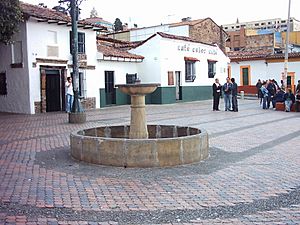Chorro de Quevedo facts for kids
The Chorro de Quevedo is a famous fountain located in the historic La Candelaria neighborhood of Bogotá, Colombia. This special place is believed to be where the Spanish explorer Gonzalo Jiménez de Quesada first started building the city of Bogotá way back in 1538. It was also a significant spot for the Muisca people, as their chief, known as the Zipa, would often look out over the beautiful Bogotá savanna from here.
In 1832, a priest named Father Quevedo bought this land and built a fountain. Sadly, the original fountain was damaged and destroyed in 1896 because a nearby bridge collapsed. Today, the Chorro de Quevedo is still a popular and vibrant area, found at the intersection of Calle 13 and Carrera 2.
Contents
A Glimpse into History
How Bogotá Began
The Chorro de Quevedo marks a very important moment in history. It is said to be the exact spot where Gonzalo Jiménez de Quesada decided to establish the city of Bogotá. He was a Spanish explorer who arrived in the area in the 1530s. This location was chosen for its good views and resources.
The Muisca Connection
Before the Spanish arrived, the land was home to the Muisca people. Their powerful leader, the Zipa, often used this elevated spot. From here, the Zipa could survey the vast and fertile Bogotá savanna. This shows how important the location was even before the city was founded.
Father Quevedo's Fountain
Many years after Bogotá was founded, in 1832, an Augustine priest named Father Quevedo bought the land. He then built a beautiful fountain there. This fountain became a central part of the area. However, it did not last forever. In 1896, the original fountain was destroyed due to damage from a collapsing bridge.
Exploring the Chapel
The Hermitage of San Miguel
In the plaza of Chorro de Quevedo, you will find a small, charming white chapel. It is called the Hermitage of San Miguel del Principe. This chapel was rebuilt in 1969. It stands on the site of the very first chapel ever built in Bogotá. The design of the current chapel is based on an older church that used to be in Santander Plaza.
Architectural Details
The steps leading up to the chapel and a nearby arch were created by an artist named Javier Olave. These features add to the unique and historic feel of the plaza. The chapel is a peaceful spot amidst the lively atmosphere of the Chorro de Quevedo.
Culture and Art in the Plaza
A Hub for Artists
The Chorro de Quevedo area is known for its lively and artistic atmosphere. Many narrow alleyways surround the plaza. These alleys are home to various artist studios and hostels. You can often see colorful street art painted on the walls nearby. This makes the area a great place for creative people.
Films and Storytelling
This historic location has even been featured in movies! Films like La Estrategia del Caracol and Diástole y Sístole were filmed here. These movies capture the unique and artistic spirit of the neighborhood. In the main square, you can often find public storytellers. They share exciting tales and legends, entertaining visitors of all ages.
Local Flavors
While exploring the Chorro de Quevedo, you might also find local shops. These places often serve traditional Colombian drinks. One popular drink you might find is called chicha. It is a traditional beverage that has been enjoyed in the region for a very long time.
See also
 In Spanish: Chorro de Quevedo para niños
In Spanish: Chorro de Quevedo para niños


